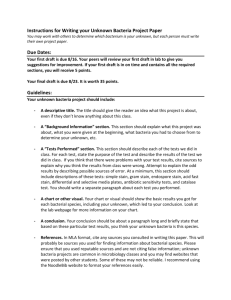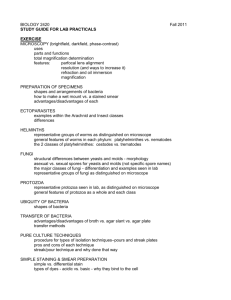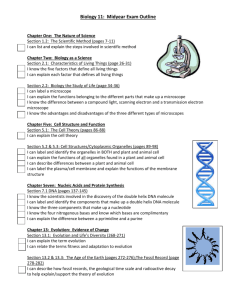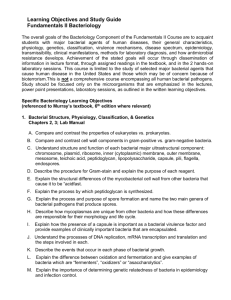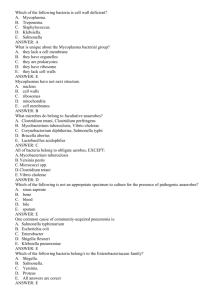MICROBIOLOGY EXAM I
advertisement
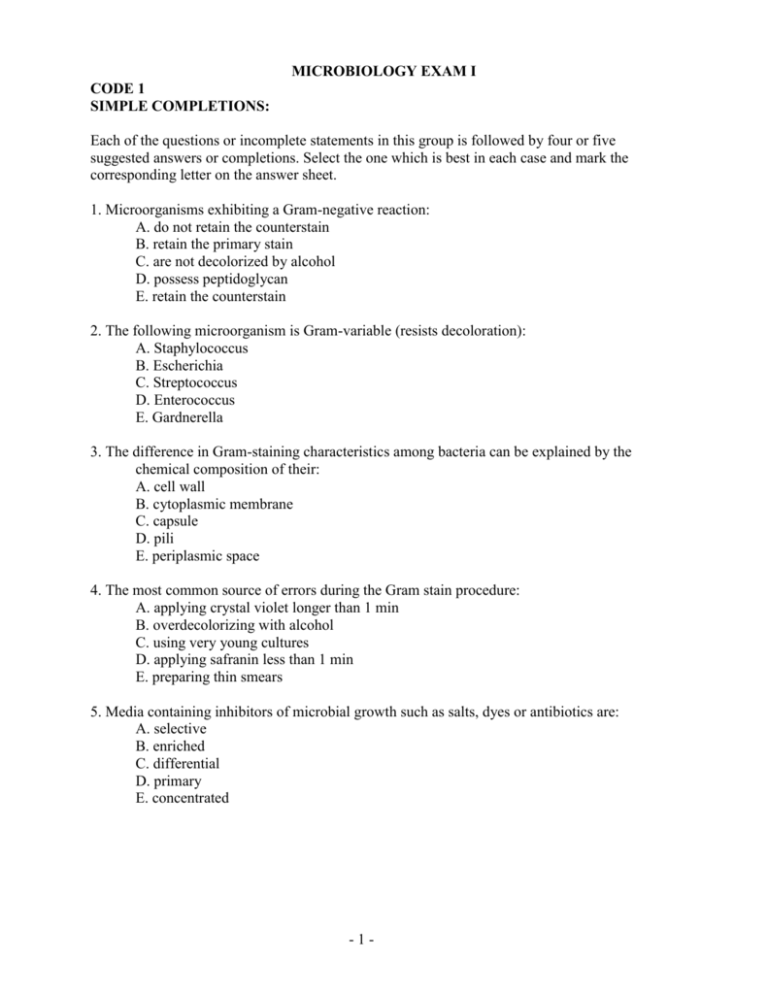
MICROBIOLOGY EXAM I CODE 1 SIMPLE COMPLETIONS: Each of the questions or incomplete statements in this group is followed by four or five suggested answers or completions. Select the one which is best in each case and mark the corresponding letter on the answer sheet. 1. Microorganisms exhibiting a Gram-negative reaction: A. do not retain the counterstain B. retain the primary stain C. are not decolorized by alcohol D. possess peptidoglycan E. retain the counterstain 2. The following microorganism is Gram-variable (resists decoloration): A. Staphylococcus B. Escherichia C. Streptococcus D. Enterococcus E. Gardnerella 3. The difference in Gram-staining characteristics among bacteria can be explained by the chemical composition of their: A. cell wall B. cytoplasmic membrane C. capsule D. pili E. periplasmic space 4. The most common source of errors during the Gram stain procedure: A. applying crystal violet longer than 1 min B. overdecolorizing with alcohol C. using very young cultures D. applying safranin less than 1 min E. preparing thin smears 5. Media containing inhibitors of microbial growth such as salts, dyes or antibiotics are: A. selective B. enriched C. differential D. primary E. concentrated -1- 6. The typical incubation time needed for colonies of aerobic and facultative bacteria to appear on agar plates is: A. 48 hours B. 24 hours C. 72 hours D. one week E. two weeks 7. Which of the following microorganisms DOES NOT have a predictable drug susceptibility pattern? A. Group B streptococcus B. Group A streptococcus C. Klebsiella pneumoniae D. Streptococcus pneumoniae E. Neisseria meningitidis 8. The most used method for routine antimicrobial susceptibility testing in clinical laboratories is the: A. disc diffusion method B. broth dilution method C. disc elution method D. agar dilution method E. colorimetric method 9. A positive chromogenic Cefinase test indicates: A. production of beta-lactamase B. resistance to Penicillin G C. resistance to Ampicillin D. resistance to Carbenicillin E. all of the above 10. The simplest test to differentiate Staphylococci from Streptococci is the: A. coagulase test B. glucose fermentation test C. Gram stain test D. catalase test E. CAMP test 11. The rapid latex-agglutination test for Staphylococcus aureus detects: A. clumping factor and Protein A B. carbohydrate C C. capsular antigen D. cell wall antigen E. toxin -2- 12. Which of the following is the most reliable method for differentiating Streptococcus pneumoniae from Streptococcus mutans? A. catalase test B. cellular morphology C. Gram stain reaction D. optochin sensitivity E. type of hemolysis 13. A young woman presents to the emergency room with hypotension, fever, gastrointestinal symptoms and a skin rash. The most likely diagnosis is: A. Scarlet fever B. Salmonellosis C. Toxic shock syndrome D. Scalded skin syndrome E. None of the above 14. Which one of the following is known to play an important role in bacterial pathogenesis? a. ribosome b. volutin c. glycogen d. fimbriae e. DNA 15. The LPS or lipopolysaccharide found in Gram-negative bacteria IS NOT composed of: a. peptidoglycan b. lipid A c. core polysaccharide d. O-antigen e. any of the above 16. Targeting antibiotic therapy against the peptidoglycan cell wall of bacteria is advantageous because the wall is: A. chemically vulnerable B. mechanically accessible C. synthetically complex D. unique to the bacterium E. None of the above 17. All Gram-positive bacteria possess: A. thickened cell walls containing mycolic acid B. outer membranes C. flagella D. capsules E. polymers of N-acetyl glucosamine and N-acetyl muramic acid -3- 18. Which of the following is true regarding bacterial nomenclature? A. Both genus and species are capitalized B. Bacterial names are either underlined or italicized C. Bacterial classification is based on mating experiments D. Cell morphology is the most important criterion in classification E. DNA content is used in laboratory identification, but not in classification 19. The cytoplasmic membrane of bacteria is important in each of the following aspects EXCEPT: A. exocytosis of proteins B. cell wall synthesis C. location of lipopolysaccharide D. oxidative phosphorylation and electron transport E. active transport of nutrients 20. Which one of the following IS NOT a correct statement about Staphylococcus aureus? A. Greater than 90% of persons carry S. aureus in their anterior nose. B. Nasal carriers of S. aureus are the persons most likely to develop Staphylococcal wound infections and boils. C. Blood cultures in patients with boils are nearly always negative. D. S. aureus is a well-recognized cause of post-influenza pneumonia 21. Which one of the following is true about respiratory tract flora? A. Escherichia coli is found in the upper respiratory tract of most people. B. Colonization of the lower respiratory tract with upper respiratory tract flora because of failure of clearing mechanisms explains "bronchitis". C. Mucociliary motility mechanisms are important in the bladder, not the respiratory tract. D. Local acid production because of high tissue concentrations of glycogen is a major factor limiting bacterial replication. 22. Which of the following IS NOT true regarding the bacterial species that comprise the body's normal flora? A. They produce something good for the body (e.g. vitamins) B. They take up space and utilize nutrients eliminating the chance for colonization by pathogenic bacteria C. They may produce antibiotics or stimulate immunity against pathogenic bacteria D. They rarely cause illness because they are not virulent. 23. Which one of the following is a "specific antimicrobial factor" directed to a microorganism to which the host has been exposed previously? A. intact mucocutaneous (mucous membranes and skin) structures B. gastric acid trap C. carbohydrate utilizing local pH and reduced bacteria D. IgA produced by local plasma cells -4- 24. Which one of the following does not render resistance to phagocytosis? A. enterotoxins produced by Vibrio cholerae B. K1 antigen produced by Escherichia coli C. M protein produced by Streptococcus pyogenes D. capsule produced by Streptococcus pneumoniae 25. Which one of the following IS NOT invasive? A. Shigella spp. B. Salmonella spp. C. Enterotoxigenic Escherichia oil D. Camtwlobacter jejuni 26. Pyrimidine dimers induced by UV light are corrected in bacteria by all of the following systems EXCEPT: A. excision repair B. photoreactivation repair C. recombinational/postreplicative repair D. SOS-induced repair E. methyl-directed-mismatch repair 27. Genetic suppression results when: A. a mutation reverts back to the wild-type DNA sequence B. a mutant tRNA molecule decodes a nonsense or missense codon C. a repressor molecule binds to an operator and prevents gene expression D. a restriction enzyme cleaves an infecting bacteriophage genome E. RNA polymerase containing an alternative sigma factor transcribes genes in a regulon 28. Which of the following genes form a regulon in bacteria? A. the tryptophan (trp) biosynthetic genes B. the lactose (lac) utilization genes C. the genes induced by the SOS response D. the genes encoding ribosomal proteins E. the genes encoding alternate sigma factors for RNA polymerase 29. Modification of cytosine bases to 5-methylcytosine (5MeC) bases in bacterial DNA results in hotspots for mutation because: A. 5MeC forms pyrimidine dimers with adjacent bases B. 5MeC spontaneously deaminates to T at high frequency C. 5MeC is a target for transposon insertion D. 5MeC causes mispairing during DNA replication E. 5MeC spontaneously depyrimidates and loses the 5MeC base 30. Vancomycin inhibits bacteria because it: A. binds to peptidoglycan precursors ending in acyl-D-alanine-D-alanine B. binds to ribosomal subunits ending in acyl-D-alanine-D-alanine C. inhibits protein synthesis D. disrupts the inner membrane -5- 31. Which one of the following has little if any activity against Gram-negative bacilli? A. Trimethoprim-sulfamethoxazole B. Fluoroquinolone. C. Vancomycin D. Cephalosporin E. Aztreonam 32. A previously healthy 8-year old presents with a large boil (carbuncle) at the back of his neck. Gram stain from incision and drainage reveals sheets of polymorphonuclear leukocytes and gram-positive cocci in clusters. Pending susceptibility testing in the laboratory, which of the following would be the most appropriate antimicrobial therapy? A. Oxacillin B. Penicillin G C. Tetracycline D. Gentamicin E. Aztreonam 33. PBP2a, the penicillin-binding protein which causes methicillin-resistance in Staphylococcus aureus, causes this resistance because it: A. blocks entry of methicillin into cells B. hydrolyzes (inactivates) methicillin C. helps synthesize cell wall in the presence of methicillin D. binds methicillin and prevents it from reaching its target site(s) 34. Resistance to which of the following has been shown to result from enzymatic inactivation of the antibiotic by bacteria? A. Rifampin B. Trimethoprim C. Fluoroquinolones D. Chloramphenicol E. Sulfonamides 35. The same beta-lactamase found in N. gonorrhoeae (gonococci) has also been found in: A. Staphylococci B. E. coli C. Bacteroides fragilis D. Treponema pallidum E. Streptococcus pyogenes 36. The diffuse vascular damage associated with meningococcal infection is in large part attributed to the action of: A. lipooligosaccharide endotoxin. B. DNA transfer from the bacterium to the host. C. sloughing of pili. D. outer membrane proteins II and III. -6- 37. For Neisseria, generation of variant pilin forms occurs naturally by: A. transduction. B. conjugal DNA transfer. C. mismatch repair. D. recombination. 38. The method of choice for identification of Neisseria isolated from mucosal surfaces other than the conjunctiva and the male urethra is: A. Gram stain. B. culture isolation. C. oxidase test. D. DNA hybridization test. MATCHING: Each set of matching questions in this section consists of a list of lettered options, followed by several numbered items. For each numbered item, select the ONE lettered option that is most associated with it. Each lettered option may be selected once, more than once, or not at all. QUESTIONS 39-40 A. Blood agar B. MacConkey agar C. PEA agar D. CNA agar E, Chocolate agar 39. _____Contains antibiotics and inhibits Gram-negative bacteria 40. _____Contains bile salts and inhibits Gram-positive bacteria QUESTIONS 41-44 Match the following organisms with the diagnostic test most useful for their identification. A. Bacitracin susceptibility B. Novobiocin resistance C. Bile esculin and 6.5% NaCl D. Bile solubility 41. _____ Enterococcus 42. _____ Streptococcus pneumoniae 43. _____ Staphylococcus saprophyticus 44. _____Streptococcus pyogenes -7- QUESTIONS 45-48 Match the following mechanisms of bacterial genetic exchange with the vehicle or process that causes the genetic exchange. A. Self-transmission of a plasmid or episome B. Competence and uptake of DNA from the culture medium C. DNA processing and packaging during phage replication D. Mistaken excision of a bacteriophage lysogen 45. _____ Generalized transduction 46. _____ Conjugation 47. _____ Transformation 48. _____ Specialized transduction TRUE OR FALSE Choose the best possible answer. A = True; B = False 49. _____ Transcription and translation of single mRNA molecules occur simultaneously in bacterial cells. 50. _____ Heat is the most common method for the sterilization of bacterial contamination in the medical laboratory. -8- ANSWERS: 25. C 26. E 27. B 28. C 29. B 30. A 31. C 32. A 33. C 34. D 35. B 36. A 37. D 38. B 39. D 40. B 41. C 42. D 43. B 44. A 45. C 46. A 47. B 48. D 49. A 50. A 1. E 2. E 3. A 4. B 5. A 6. B 7. C 8. A 9. E 10. D 11. A 12. D 13. C 14. D 15. A 16. D 17. E 18. B 19. C 20. A 21. B 22. D 23. D 24. A -9-


